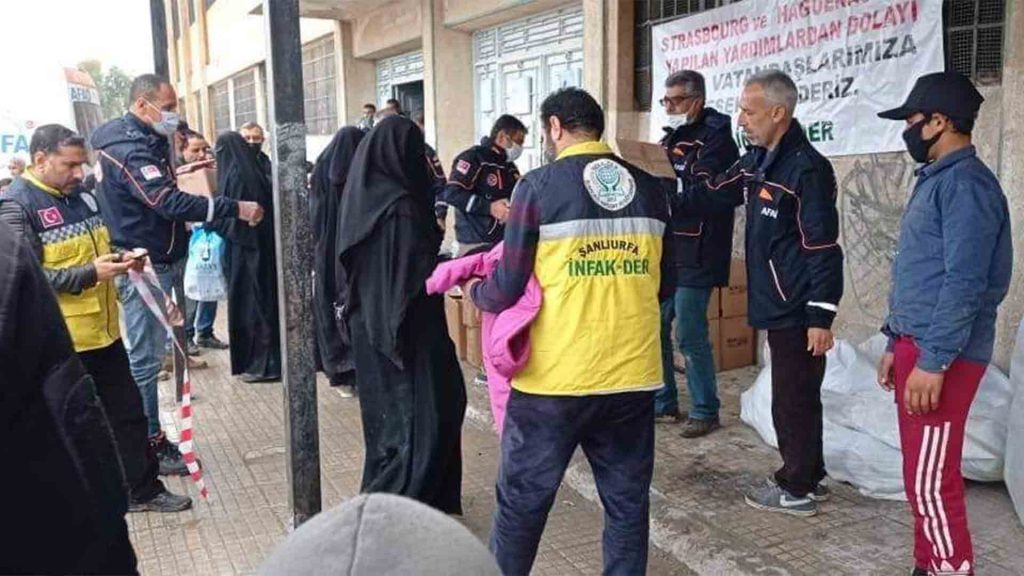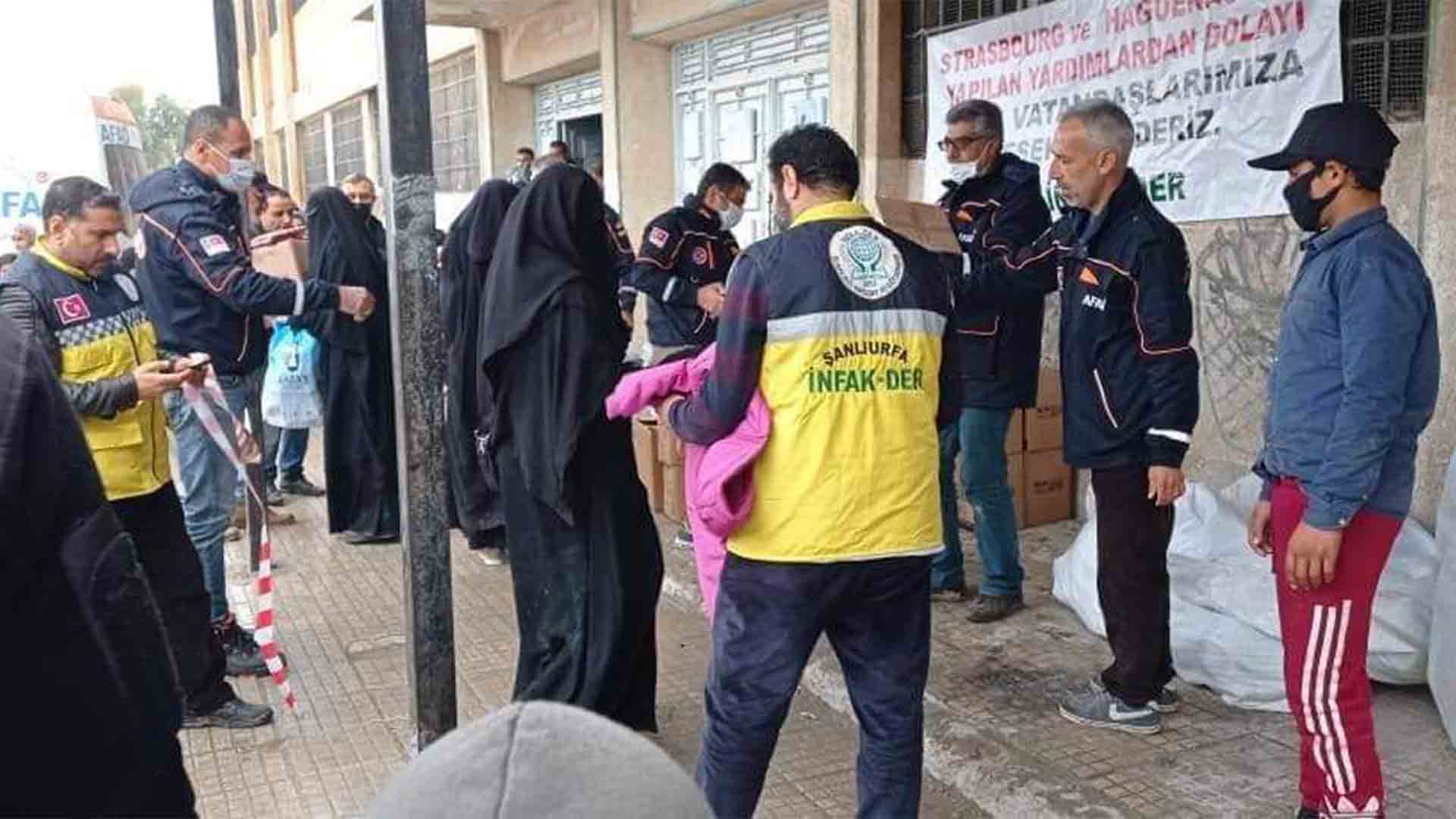HASAKAH, Syria (North Press) – Media websites close to the Turkish-backed armed opposition groups published photos in mid-December showing the distribution of aid to Iraqi refugees in the city of Sere Kaniye (Ras Al-Ain), northeastern Syria.
Social media users wondered how the Iraqi refugees managed to get to Sere Kaniye, near the Syrian-Turkish border.

This came at a time when the Autonomous Administration of North and East Syria (AANES) and Sere Kaniye’s IDPs accused the Turkish troops and armed opposition groups of committing war crimes, implementing systematic demographic change, and following a Turkification policy in the area.
The invasion by Turkish forces and their affiliated armed opposition groups last year displaced hundreds of thousands from Sere Kaniye (Ras Al-Ain) and Tel Abyad (Gire Spi).
From Ain Issa Camp?
“Iraqi families and families from other nationalities are found in districts in Sere Kaniye, settling in houses of the indigenous Kurdish and Arab people who fled the city,” Orhan Kemal, a media activist from Sere Kaniye, told North Press.
Sultan Murad Division, which was supported by Turkey and has a majority of Syrian Turkmen, is taking care of and protecting these new families, he added.
Kemal expects that those whom the opposition is talking about have come to the city in the middle of September.
In a statement to North Press, Major Youssef Hammoud, spokesman of the opposition Syrian National Army groups, denied the arrival of Iraqi or other refugees to Sere Kaniye recently.
“We transferred those families from Ain Issa Camp during the fighting against the Syrian Democratic Forces (SDF), while others were in our areas previously,” he stated.
Late last year, the armed opposition groups managed to reach to Ain Issa Camp in the northern Raqqa countryside, and smuggled out most of its inhabitants, including families of the Islamic State (ISIS).
For over a year under the Turkish occupation in Sere Kaniye, human rights, local, and international reports have documented the looting of people’s possessions, destruction of infrastructure, and demographic change that ruined the city which once embraced different communities.
Or from Hawl?
Some activists suspect that these families actually came from Hawl Camp, east of Hasakah.
Some Iraqi families have managed to escape from the camp, Hawl Camp official Hamrin Hassan said in a phone call with North Press without elaborating further on the incidents or the numbers of those who fled.
Ten days ago, a group of Iraqi ISIS families were arrested during an escape attempt, she added.
However, Turkey announced in July that it had smuggled a Moldovan mother and her four children from Hawl Camp in an operation which it deemed as “intelligence.”
Meanwhile, the SDF and the Internal Security Forces (Asayish) face difficulty in controlling over 150 kilometers of border with Turkey, extending from the town of Zargan, north of Hasakah, to the town of Ain Issa, north of Raqqa.
Aram Hana, an official in the SDF-affiliated Syriac Military Council, says that a lot of smuggling operations are happening there due to the border’s length.
Hana added that most of the smuggling process takes place via the M4 Highway, pointing out that they have monitored many cases of both human and cargo smuggling.
Are they ISIS?
Youssef Hammoud denies that families which were housed in Sere Kaniye have any ties with ISIS.
However, Orhan Kemal said that he managed to obtain photos of Iraqi women in a market in Sere Kaniye. Additionally, the raising of ISIS flags during a demonstration in the city center of Sere Kaniye in October increased suspicions of the presence of ISIS militants there.
The spokesman of the National Army said, “one of our militants raised the ISIS flag; however, he was brought in front of a military court to be sentenced legally.”
Furthermore, regarding the duration of the families’ presence in opposition-held areas, Hammoud stated that he did not have enough data about those families.
“It is possible to ask the local councils in these areas,” he added.
North Press tried to contact the local councils in Sere Kaniye; however, they did not respond.
Kemal confirmed that he had previously suspected ISIS presence in the city, but after raising their flags and publishing photos of those families, he became almost certain of ISIS’ presence there.
Demographic change
Activists used to liken the city of Sere Kaniye, before Turkey and the armed opposition groups took control of the city, to a miniature model of Syria, since it was home to Kurds, Arabs, Armenians, Circassians, Syriacs, and Assyrians.
They add that the opposition forces there are implementing demographic change by settling opposition groups’ families in the city and giving them the original inhabitants’ possessions and shops, while Turkey unfurls its symbols and flags throughout the city.
Displaced activists and journalists from Sere Kaniye launched an online initiative in October to support IDPs from their city, coinciding with the approaching anniversary of the Turkish aggression on the city.
“City of Coexistence Losing its Colors” was the slogan of the initiative, remembering the city that was once a center of coexistence for Kurds, Arabs, Chaldeans, Assyrians, Syriacs, Turkmen, Muslims, and Christians.

In November, Sarah Leah Whitson, a former director of the Middle East and North Africa division of Human Rights Watch, confirmed that violations, including executions and home confiscations, had occurred in areas held by Turkey.
Whitson added that looting of property, banning IDPs from returning to their homes, and executions were all evidence that the “safe” areas suggested by Turkey would be anything but safe.
Turkey, the armed opposition groups, and officials of the Syrian opposition coalition deny that these violations ever took place, while activists believe that the main reason for incomplete investigations into these accusations is that the entities there silence people.
“Documenting such cases is difficult, because Turkey prevents media from entering the city except for media affiliated with it,” Kemal stressed.
“If Turkey was serious about denying those violations, it would allow other media in to discern the conditions of the area after a year under its control,” he added.

